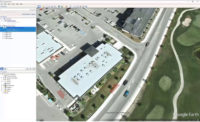
I look back fondly to the days when jumping on a plane was synonymous with reconnecting to silence; when transoceanic flights were absent of the buzz of emails, phones and social media’s barrage of connectivity. But when United Airlines began adding in-flight WiFi this fall, I folded. No longer do I look forward to reflective, stress-free hours. For as much as I want to keep the computer in the overhead bin, I cannot help but appreciate the opportunity for a few extra hours of access.
Perhaps in-flight access will take a bit of getting used to, but connectivity has revolutionized the way Bridges to Prosperity has been able to efficiently and effectively work in some of the least developed countries around the world. Today, I have the same connectivity at 30,000 feet, half way to Rwanda, as I have in my own office. I can still write this article; I can connect to our cloud-space server to modify an engineering drawing, or check on the number of villagers who have crossed a bridge in La Tana, Guatemala within the last hour. It’s really wild.
The role that technology and connectivity play in advancing the goals of organizations, companies and individuals who work in some of the world’s most remote places is immense. This morning started with a Skype call to East Timor, followed by a Google Hangout meeting with staff in Virginia and a check-in to our Box.com account to check homework assignments uploaded via our website. Bridges to Prosperity is so reliant on the tools of remote connectivity that is difficult for me to wrap my head around how much more complex (and expensive!) running a global organization would have been even just a decade ago.
A group of organizations, agencies and companies have come together to, instead of design for 10% of the world's richest customers, design for the other 90% of the world market. The group calls itself the D90 movement—designing for the 90% to fight extreme poverty. Extreme poverty has a noticeably rural face, often in areas far from city centers, and often far from home offices of organizations aiming to provide support.
An estimated 300 million rural villagers in some of the world’s least developed countries are faced with daily struggles due to a lack of access: access to healthcare, to education, to markets, secure food sources and potable water. The D90 movement began from asking a fairly simple question: why is the AEC community not devising cost-effective ways to increase access to services for those who need those services the very most? Technology developments are rapidly bridging the geographic divide between rural communities and the folks at home partnering to find solutions to prosperity.
Access to communication tools are helping bridge the gap for volunteers as well as those of us working for international development organizations. Architects from Oregon designed an off-grid solar power system for a community in the Democratic Republic of Congo. Engineers from New York designed a safe water source for a health center in Kenya and contractors from across the US just returned home from building a cable-suspension bridge in Nicaragua. By partnering with organizations and individuals who live and work in these remote areas, to tools of connectivity are improving the AEC communities’ ability to connect with their on-the ground partners before travel, while on site and in some cases, to view the long term impacts of their project.
Bridges to Prosperity has partnered with Portland State University and SWEETSense to develop low-cost and robust sensors that report traffic data on bridges in remote villages. Capitalizing on the widespread coverage of the cellular network, remote monitoring devices capture traffic data and report via cellular networks. Bridges showing traffic peaks at 8:00 am and again at 3:00 pm help to reaffirm social survey information indicating that these structures are providing safe access to school. Conversely, a monitor reporting abnormally low traffic could indicate structural concerns. I am not proposing that computer bots interpreting data will replace the essential in-person, on the ground information gathering, but I would argue that the power of communication tools and technologies will continue to dramatically improve the efficiency and efficacy of initiatives half a world away.
The community of international development professionals, philanthropically-minded supporters and volunteers alike are all able to connect to the beneficiary communities in new ways: our field staff are able to host technical and safety debriefings, and view construction schedule updates and bridge usage information from just about everywhere we work (with projects in 14 countries, many sites which are several days travel from the comforts of a hotel). Thanks to a cellular network that now covers some of the most remote corners of the world, we are truly a global village.
Avery Louise Bang is executive director of Bridges to Prosperity (B2P), a 501 c 3 non-profit organization that believes basic access is a human right. B2P has built more than 100 bridges in 16 countries, connecting over 500,000 people to basic services. bridgestoprosperity.org




Post a comment to this article
Report Abusive Comment